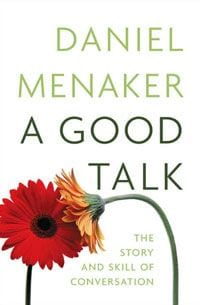
There’s something intangibly fulfilling about a good talk. That something isn’t found in A Good Talk.
Daniel Menaker, a 25-plus year veteran of The New Yorker is undoubtedly an entertaining character and an equally fine writer. Here, however, he gets lost somewhere between the subtitle’s Story and Skill, and often ends up sounding self-absorbed. Elsewhere, he’s doing his best to erect erudite colloquialisms within the book’s somewhat commonsense contents. Too many of these 220 pages feel like a one-sided conversation with a sly but talkative cocktail hour chum.
The initial chapter boldly, and yet succinctly, surveys the history of conversation, citing genes, grooming, gossip, and Garfinkel along the way. Menaker’s personality is least evident here, though his style is quite apparent from the first few pages: informative yet quirky, self-effacing and yet intellectual. There’s an ease to the author’s erudition that enables even well-researched examinations to appear unobtrusive. This “Talking History” chapter could convince the reader that it might be nice to sit down and chat with the affable Menaker.
Until chapter two, when you actually have to. Well, not exactly, but in order to illustrate a conversation’s typical arc and ebbs — here titled “Survey, Discovery, Risks, and Roles” — the author records, and recapitulates, a conversation between himself and a fellow author. Menaker thoroughly details how his first five attempts at recording the conversations of others failed, and so decides that “if the sixth attempt was going to be screwed up, [he] was going to do the screwing up [himself].” Though the author is an acquaintance of “Ginger”, their 90-minute lunch in a Brooklyn sushi joint is meant to reveal some of the complexities of “purely social talk between people who are not close friends”.
Menaker breaks every few pages of conversation to offer analysis on compliments, pitfalls, name-dropping, and interrupting — all of which he broaches during the conversation itself, offering fodder for analysis. This leads the reader to wonder, through the anthropologist’s lens, if the experiment wouldn’t have been more productive and believable if the author had ultimately chosen two strangers to observe and record.
As is, the end result is somewhat distracting and consciously self-reflexive, similar to my above attempts at all-inclusive alliteration, along with the fact that I am now highlighting this fact. It feels full of folly, forced, and foremost, fake. Particularly since Menaker, former executive at Random House, has professional upper hand on the younger Ginger, who is angling to be published.
Despite the duo’s difference in age, topics surveyed include both the Arcade Fire and Neko Case, which any reader of this site wouldn’t be surprised to see: as we know, pop matters. Menaker, of course, comes across as a superb conversationalist, well-versed in a cross-section of topics while also having the gatekeeper’s ability to link Ginger to icons of the publishing world. If Menaker has a fault, it is his love of, and public admission of that love of, modern country music. Toby Keith? Really?
The conversation chapter is followed by a cross-section of FAQs: Frequently Arising Quandaries. One might guess most of these conversational anomalies, which include changing the subject, boredom, and insults. The reader is then surprisingly thrown into the “Electronica” sub-section, where suddenly advice is given regarding email. For a book about conversation, that includes a conversation, a section on e-etiquette is the equivalent of mentioning the weather when you are at a loss for other subjects.
It isn’t until the 178th page that the reader receives specific advice on the subtitle’s skill of conversation. Menaker proposes that CHI — curiosity, humor, and impudence — are the vital elements of a good conversationalist. After delving into each of these, the author ultimately concludes by stating his belief that “every time people talk together in a social and mutually gratifying way, the world becomes a better place”, and that “some good conversations linger, like … the memory of sunlight after dark”. Which seems fairly commonsense, both on an instinctual level and a scientific one.

![Call for Papers: All Things Reconsidered [MUSIC] May-August 2024](https://www.popmatters.com/wp-content/uploads/2024/04/all-things-reconsidered-call-music-may-2024-720x380.jpg)



